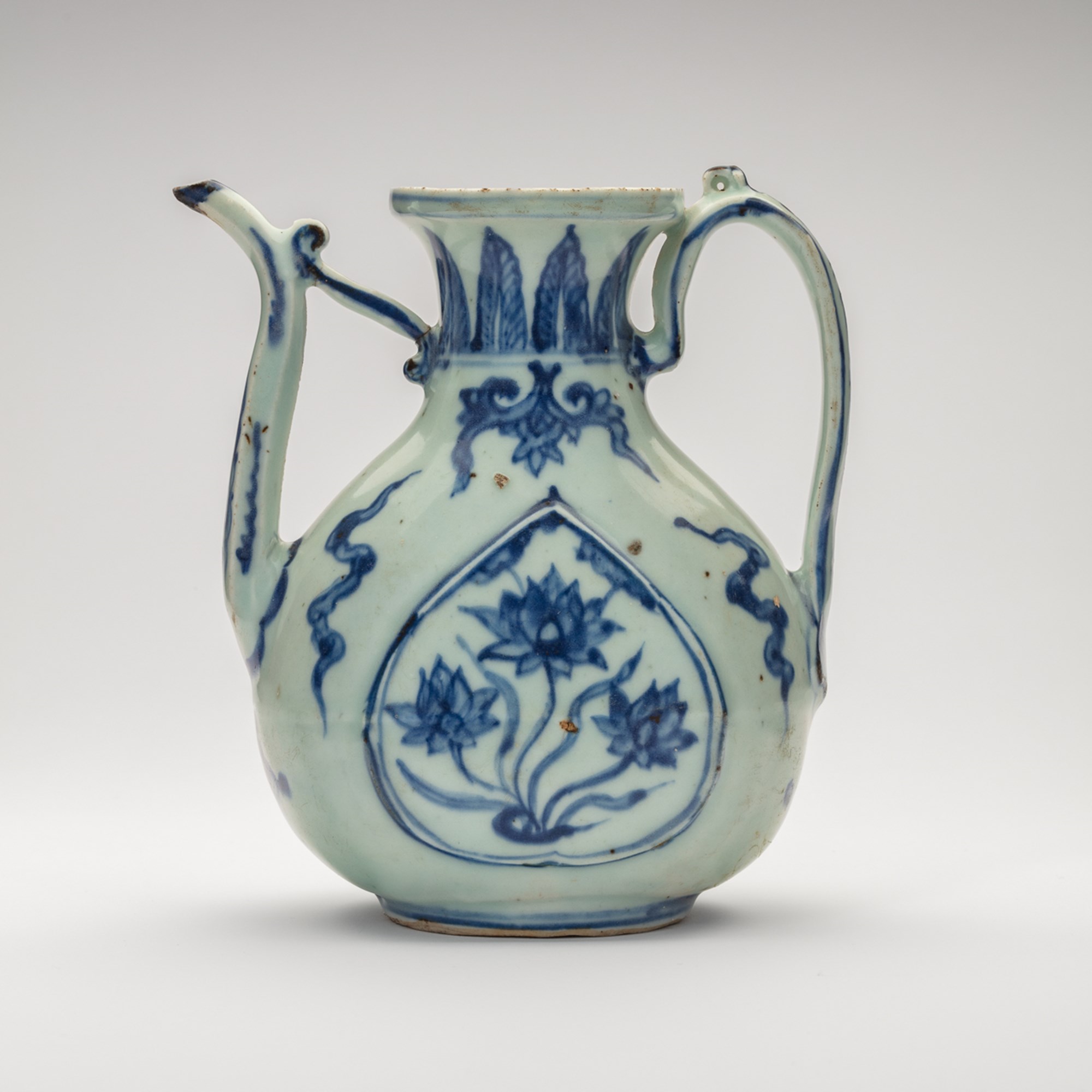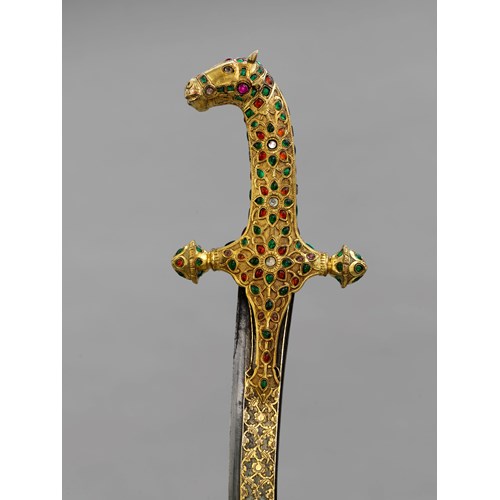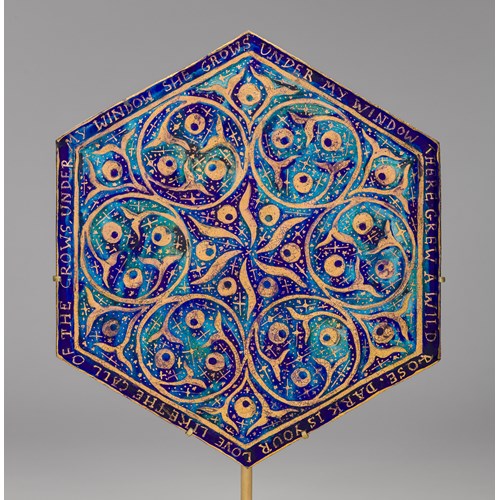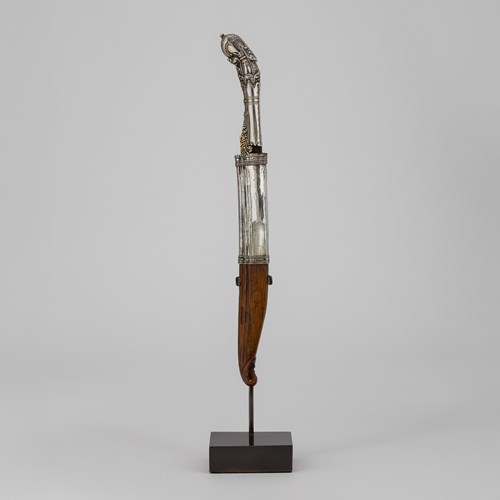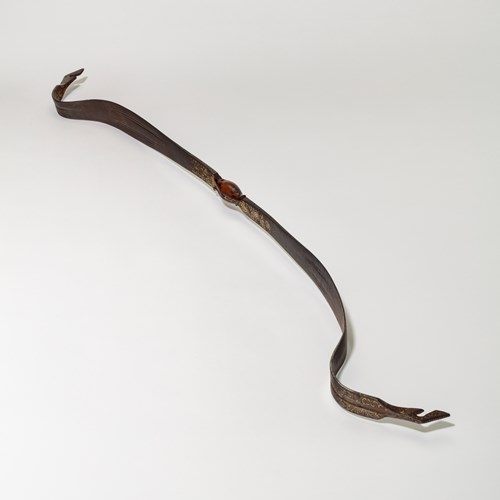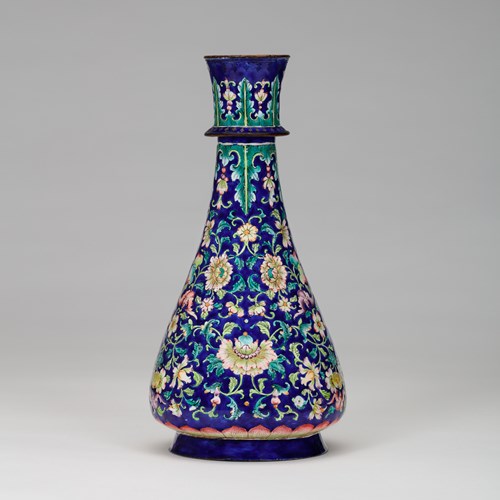Marketplace
A Chinese Blue and White Ewer made for the Islamic market
A Chinese Blue and White Ewer made for the Islamic market
Epoque Yuan Dynasty
Origine China, Yuan Dynasty
Medium Ceramic
Dimension 17 x 16 cm (6³/₄ x 6¹/₄ inches)
A fundamental revolution occurred in the history of Chinese porcelain in the fourteenth century under the domination of the Mongols, and this revolution had an enormous impact on the Near East, and ultimately on Europe. The Chinese developed blue and white porcelain almost exclusively for the benefit of the Middle Eastern market so the designs, far from being Chinese in conception were in fact Islamic, and consequently in terms of the treatment of shape and surface there was a clear dependence upon Islamic traditions. The merchants of Persia and Syria were the two groups most interested in Chinese blue and white.[1]
The vivid blue that was used to decorate this new style of ceramic was also an import from the Middle East, coming from the small village of Qamsar (or Khamsar) thirty-five kilometres south west from Kashan in Central Iran. The abundant Qamsar deposits include cobalts that are high in iron, high in nickel, high in copper, and high in manganese. All the underglaze-blue pigments on Chinese Yuan dynasty porcelain that have so far been examined are of the same constitution, i.e. high-iron cobalts with minimal manganese contents.
The Iranian cobalt has been described by Abu’l Qasim, who wrote a treatise on tiles and other ceramics in A.H.700 (AD 1301). Abu’l Qasim was a member of a prominent potter family at Kashan, and a Mongol court historian at Tabriz.[2] His text provided a very complete description of processes for forming, painting and firing ceramics in Persia in the thirteenth century. About cobalt it reported:
.... The stone lajvard, that the craftsmen call sulaimani, its source is the village of Qamsar in the mountains round Kashan, and the people there claim it was discovered by the prophet Sulaiman. It is like white silver shining in a sheath of hard black stone. From it comes the lajvard colour, like that of lajvard-coloured glaze. [3]
In Persian, the sang-i lajvard means lapis lazuli, though here the term must be used for cobalt. Cobalt was often used as part of the composition of fake gemstones imitating lapis lazuli.
Thus we can see that this porcelain ewer is Islamic in shape, in decoration and in the cobalt mineral with which it is decorated. It was made to have a lid, as indicated by the loop on the handle, but all too frequently porcelain lids become detached and either lost or broken. The only Chinese element of the piece is its pattern, which shows flowering lotus in the raised ogival panels on the body, and rising lotus petals on the neck.
[1] Margaret Medley, “Islam, Chinese Porcelain and Ardabīl”, Iran Vol. 13 (Taylor & Francis, Ltd , Abingdon on Thames, 1975), pp. 31-37 .
[2] Oliver Watson, Persian Lustre Ware (Faber and Faber, London, 1985), pp.31-2.
[3] For a description and translation of the text, see James Wilson Allan, "Abu'l Qasim's Treatise on Ceramics” Iran Vol. 11 (Taylor & Francis, Ltd , Abingdon on Thames, 1973), pp.112, 116, 120.
Yuan Dynasty
Stock no.: A5358
The vivid blue that was used to decorate this new style of ceramic was also an import from the Middle East, coming from the small village of Qamsar (or Khamsar) thirty-five kilometres south west from Kashan in Central Iran. The abundant Qamsar deposits include cobalts that are high in iron, high in nickel, high in copper, and high in manganese. All the underglaze-blue pigments on Chinese Yuan dynasty porcelain that have so far been examined are of the same constitution, i.e. high-iron cobalts with minimal manganese contents.
The Iranian cobalt has been described by Abu’l Qasim, who wrote a treatise on tiles and other ceramics in A.H.700 (AD 1301). Abu’l Qasim was a member of a prominent potter family at Kashan, and a Mongol court historian at Tabriz.[2] His text provided a very complete description of processes for forming, painting and firing ceramics in Persia in the thirteenth century. About cobalt it reported:
.... The stone lajvard, that the craftsmen call sulaimani, its source is the village of Qamsar in the mountains round Kashan, and the people there claim it was discovered by the prophet Sulaiman. It is like white silver shining in a sheath of hard black stone. From it comes the lajvard colour, like that of lajvard-coloured glaze. [3]
In Persian, the sang-i lajvard means lapis lazuli, though here the term must be used for cobalt. Cobalt was often used as part of the composition of fake gemstones imitating lapis lazuli.
Thus we can see that this porcelain ewer is Islamic in shape, in decoration and in the cobalt mineral with which it is decorated. It was made to have a lid, as indicated by the loop on the handle, but all too frequently porcelain lids become detached and either lost or broken. The only Chinese element of the piece is its pattern, which shows flowering lotus in the raised ogival panels on the body, and rising lotus petals on the neck.
[1] Margaret Medley, “Islam, Chinese Porcelain and Ardabīl”, Iran Vol. 13 (Taylor & Francis, Ltd , Abingdon on Thames, 1975), pp. 31-37 .
[2] Oliver Watson, Persian Lustre Ware (Faber and Faber, London, 1985), pp.31-2.
[3] For a description and translation of the text, see James Wilson Allan, "Abu'l Qasim's Treatise on Ceramics” Iran Vol. 11 (Taylor & Francis, Ltd , Abingdon on Thames, 1973), pp.112, 116, 120.
Yuan Dynasty
Stock no.: A5358
Epoque: Yuan Dynasty
Origine: China, Yuan Dynasty
Medium: Ceramic
Dimension: 17 x 16 cm (6³/₄ x 6¹/₄ inches)
Provenance: American Private Collection
Plus d'œuvres d'art de la Galerie


